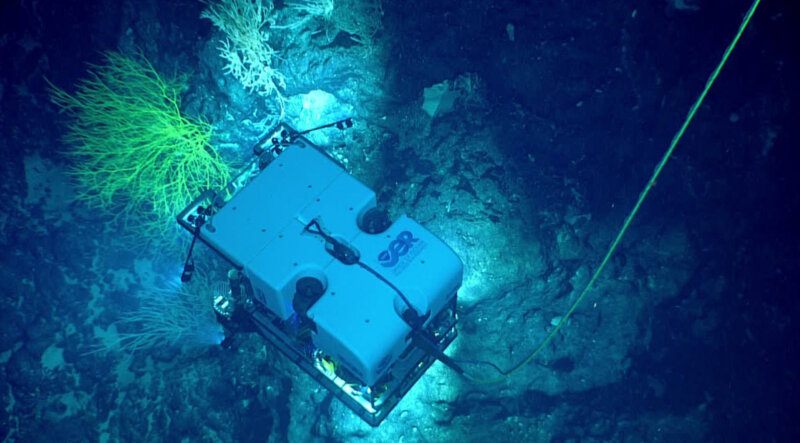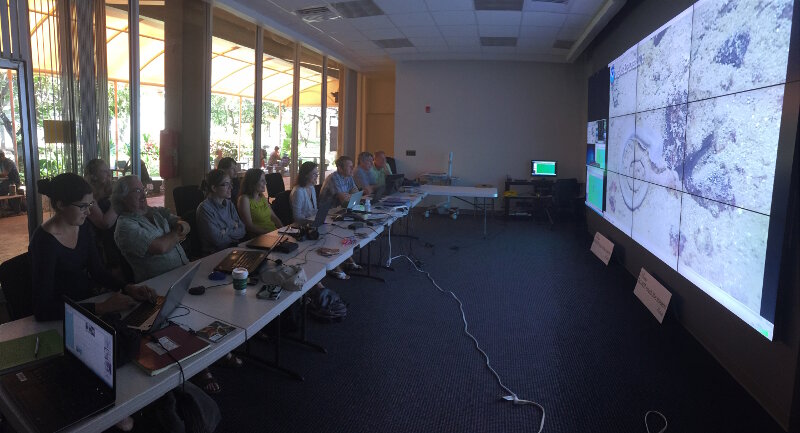
By Kasey Cantwell, Expedition Coordinator, NOAA Office of Ocean Exploration and Research
Meagan Putts, Science Lead - University of Hawaii at Manoa
John R. Smith, Science Lead - University of Hawaii at Manoa

During the expedition, NOAA’s ROV Deep Discoverer will be used to acquire high-definition visual data and collect limited samples in poorly explored areas near the boundaries of Papahānaumokuākea Marine National Monument and in the Musicians Seamounts. Image courtesy of the NOAA Office of Ocean Exploration and Research. Download larger version (jpg, 448 KB).
From September 6 to 30, 2017, NOAA and partners will conduct a telepresence-enabled ocean exploration expedition on NOAA Ship Okeanos Explorer to collect critical baseline information about unknown and poorly understood deepwater areas around the Musicians Seamounts and the Hawaiian Islands. During the Deep-Sea Symphony: Exploring the Musicians Seamounts expedition, our at-sea and shore-based science teams will work together to map the seafloor and make the first deepwater observations in these areas.

Map of the general expedition operating area. The yellow line is the rough cruise track through the Musicians Seamounts during the Deep-Sea Symphony expedition. The green polygon represents the boundary of the Papahānaumokuākea Marine National Monument. The white line represents the U.S. exclusive economic zone. Planned ROV dives are represented by white circles. Twenty-three ROV dives are expected during this expedition. Image courtesy of the NOAA Office of Ocean Exploration and Research. Download larger version (jpg, 405 KB).
This expedition is part of a three-year Campaign to Address the Pacific monument Science, Technology, and Ocean NEeds (CAPSTONE), an initiative to collect deepwater baseline information to support science and management decisions in and around U.S. marine protected areas (MPAs) in the central and western Pacific.
The Deep-Sea Symphony: Exploring the Musicians Seamounts expedition will address science themes and priority areas put forward by scientists and managers from NOAA, management agencies in the region, and the ocean science community. NOAA priorities for the expedition include a combination of science, education, outreach, and open data objectives that will support management decisions at multiple levels:
Located northwest of the main Hawaiian Islands, the Musicians Seamounts are largely unexplored. Small portions of this 650 nautical mile seamount chain have been previously mapped during transits, but the Deep-Sea Symphony expedition will involve the first dedicated mapping operations and exploration using an ROV to help us understand this fascinating region that lies just outside the U.S. EEZ.
Marine animals, such as fish and corals, do not recognize geopolitical boundaries of the world’s ocean. As one of the closest seamount groups to the Hawaiian Islands, the Musicians may serve as refuge for transient fish populations that Hawaii relies upon, provide additional habitat, and serve as a pool of genetic diversity for deep sea coral populations known from the deep waters around the Hawaiian Islands. It is also important to characterize the habitats that lie on the borders of Papahānaumokuākea Marine National Monument in order to make informed management decisions and better understand potential connectivity with the surrounding waters.
Additionally, the Musicians Seamounts offer a unique opportunity to expand our geological knowledge of fracture zones, hotspot volcanism, and how these features interact in areas where they coexist. Furthermore, this expedition will fill in gaps in data regarding seamount geomorphology and manganese crust accretion.
During the expedition, we will conduct 24-hour operations consisting of daytime ROV dives and overnight mapping operations. The 23 planned ROV dive sites are expected to include deep-sea coral and sponge habitats, bottomfish habitats, seamounts, and an investigation of habitats within the Murray Fracture Zone and areas of cultural heritage and marine archeological significance.
Prior to NOAA’s Musicians Seamounts Telepresence Mapping expedition in August 2017, there was very little high-resolution multibeam mapping over Musicians Seamount chain. During this cruise, we will continue to expand bathymetry coverage, leaving behind a rich legacy of publicly available data that reveals likely dozens of new features.
NOAA works with the scientific and resource management communities to characterize these areas through telepresence-based exploration. Operations use the ship’s deepwater mapping systems, NOAA’s dual-bodied 6,000-meter ROVs Deep Discoverer (D2) and Seirios, and a high-bandwidth satellite connection for real-time ship-to-shore communications. ROV dives will include high-resolution visual surveys and limited sampling. This expedition will help establish foundational information in the region to catalyze further exploration, research, and management activities.
Live video of dives can be viewed online in real time from September 7 - 29 2017, typically from about 8 am to 5 pm HST (2 pm to 12 am EDT).
Telepresence technology allows us to engage the majority of the science team from shore. NOAA uses telepresence technology to transmit data in real time to a shore-based team of scientists who actively participate in expeditions. Scientists participating from around the world contribute their expertise to operations in real time when discoveries are made at sea.
These shore-based scientists interact with the ship through a teleconference line and Internet collaboration tools. Using these communication tools, scientists and students help guide at-sea operations in real time, extending the reach of ocean exploration to more scientists and students than could possibly be accommodated onboard of any single vessel.
Several scientists will also work together and stand watches at Exploration Command Centers (ECCs). When Okeanos Explorer expeditions first started, ECCs were the only way that scientists could engage with the ship in real time. As technology has advanced, scientists located anywhere with an Internet connection can participate in missions. However, many scientists still prefer to be co-located with their colleagues at an ECC, as is the closest atmosphere to being in the collaborative environment that naturally forms on a ship. Also, working from an ECC removes scientists from their busy lives and allows them to focus on the expedition.

Scientists participating at the University of Hawaii ECC. Collaboration among different fields of study is easily fostered with so many scientists working together in one location. Image courtesy of the NOAA Office of Ocean Exploration and Research. Download larger version (jpg, 8.3 MB).
The same technology that allows scientists around the world to participate in the expedition from land also enables interested members of the public to experience deep-sea exploration, the wonder of discovery, and the fascination of science in real time! The live video feeds are available to anyone online, providing the public with a front row seat to discoveries as they are made.
Web content developed for this expedition includes background essays; mission logs; daily updates; videos and images; and a live video feed. Education materials allow educators and students to engage their classrooms using products tied to the expedition, including standards-based lesson plans, background information, ocean career connections, links to previous Office of Ocean Exploration and Research-sponsored expeditions, and more.